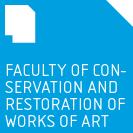Conservation and restoration of the panel painting Madonna and Child, 18th century,
copy of Cambrai Madonna and Child
Supervisor:
Assistant Professor Krzysztof Chmielewski
Studio of Conservation and Restoration of Panel Painting
and Polychrome Wooden Sculpture
///
Often the works of art that find their way into the hands of a conservator hide
secrets about their past. We do not know the author, exact time and origin of a work,
its subsequent fate. We cannot logically connect seemingly contradictory
information we have. It raises additional challenges, sometimes far beyond
the technical and artistic confines of actual conservation. When the conservator
is able to meet these challenges, making an effort to at least partly clarify these
issues, it is always beneficial, not least for ensuring accurate decisions in the field
of conservation are made. Some answers are contained in the actual piece of art
– its technology, iconography, distinctive marks. They often appear only after
the conservation work begins, when the original surface of the painting is purified
and freed from subsequent overcoatings. Other traces may be found elsewhere
– in written sources, oral evidence, other works containing similar features.
In order to restore a convincing whole from this always incomplete mosaic
of information, one not only has to have specific knowledge but also certain features,
such as detective-like inquisitiveness and persistence. Thanks to this effort, at the end
of the conservation process we often know much more than at the beginning.
Such was also the case with Agnieszka Potrzebnicka-Romanowicz’s degree piece.
A small picture painted on a thin wooden panel, with the distinctive features of early
Italian painting, and inscriptions and seals on the back, the piece provoked an attempt
to explain at least part of the puzzle. Today we know that it was painted in Northern
Europe in the eighteenth century, although it carries the stylistic features of much
earlier Southern painting. We know why this was the case and why the name
of the famous painter Cimabue was placed on the reverse of the panel, although
we do not know who painted this picture. We do know, however, that it is a copy
and we know its direct source. We also know why the painting was a valuable
possession of several prominent families of European aristocracy and when it came
to Poland. Agnieszka Potrzebnicka-Romanowicz, thanks to her talent and knowledge,
has not only restored the lost splendour to the image of Madonna and Child,
but also revealed its history – and that always gives the proper meaning to the work.
B. 1983, studied at the Faculty of Conservation and Restoration of the Works of Art,
majoring in conservation and restauration of painting and polychrome wooden
sculpture (2003–2011).








































